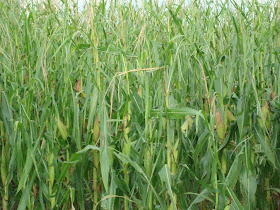
I love raising cattle. I love calving season, even though the weather is sometimes not the best. Just seeing those newborn calves running around, tails straight up; it's an awesome feeling. I love checking cows in the summertime when the grass is green and they are out grazing in the big pastures. I love seeing the calves grow throughout the year and seeing that what we are doing is really working. I love picking out heifers to keep and add to our herd. I love selling calves. Really, who wouldn't? It's the paycheck for a whole year of work.
I left out one important part of the cattle process. Weaning. I do NOT love this. It is my least favorite part of having cattle. I guess it's because I'm a softy. Weaning is when we separate the calves from their mothers so they can be put on a feed diet and eventually be sold. The calves go from nursing their mothers to eating a grain based ration that consists of corn, protein, mineral, silage and of course hay. The first week or so after they are weaned can get pretty loud outside. The calves are bawling, or 'crying' if you will, for their mothers. They have never been separated from their mothers for this long. This may seem mean, or inhuman, but it is part of the process. By this time, the calves are weighing 600 to 700 pounds and are nine to ten months old, so they are ready to be on their own. The cows have to be weaned from their calf so they can get in shape to have a new baby in a few months. After a week or so the calves quit 'crying' for their mothers, and the the process of growing them really starts to pick up.

The heifers all lined up at the bunk eating their dinner.
Once we pull the calves off their mothers they are brought to a big pen at our house. This pen has a long row of bunks where they eat. We start out by feeding them square bales of hay and and a certain type of feed that has medication in it to prevent sickness. We feed them square bales in the bunks to get them used to eating in a bunk line. They have never done that before. We then switch to a corn and protein mixture with mineral. At this time we add corn silage. As you have read in previous posts, corn silage is the whole corn plant ground up. This has a very high feed value and is also very high in energy. The calves just love it, especially on those cold mornings. They will remain at our house until it is time to sell. The rewarding part about this stage in the process is that I get to see the calves everyday, and I also get to see that all the hard work we have done throughout the year has really paid off.
Raising cattle takes a lot of time, money, and patience, but you don't have to cry about it.
Thanks for reading,
Adam

The calves are fed this pellet ration twice a day until it is
time to switch them to the corn ration.

Remember the making hay while the sun shines post? Well
all of the hay we put in the barn is now being fed to the calves.

Putting a round bale of brome hay into
the hay feeder for the calves to eat.





















































